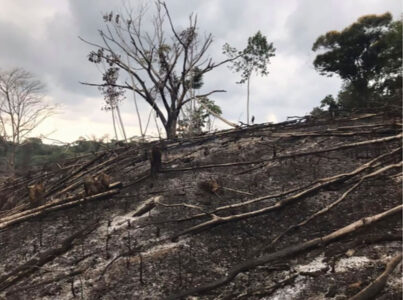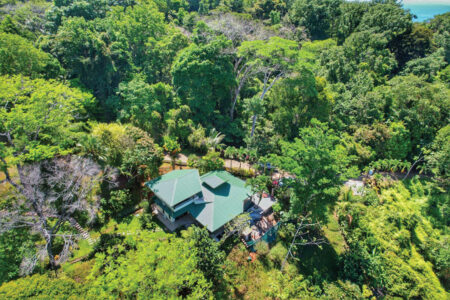Sustainable Development: They Don’t Have to Pave Paradise, Put Up a Parking Lot
by Ryan Meczkowski
Local Naturalist Guide, CR Naturalist Experiences
 Call it Paradise Lost. Whenever there is a special place, a Shangri-La if you will, that outsiders discover and fall in love with, this place ultimately gets developed and loses its essence. For many, that place is Costa Ballena and they fear that this fate is happening as we speak. Last month, at an event, hosted by the Instituto Costaricense de Turismo (ICT), local business owners were asked their biggest concern for the future of the Costa Ballena area. Their response: unsustainable development.
Call it Paradise Lost. Whenever there is a special place, a Shangri-La if you will, that outsiders discover and fall in love with, this place ultimately gets developed and loses its essence. For many, that place is Costa Ballena and they fear that this fate is happening as we speak. Last month, at an event, hosted by the Instituto Costaricense de Turismo (ICT), local business owners were asked their biggest concern for the future of the Costa Ballena area. Their response: unsustainable development.
 However, it is not a foregone conclusion. About 40 years ago, Costa Ballena consisted mostly of farm and ranchland. Jack Ewing, President of the Board of Directors of ASANA, which manages the Paso de la Danta, a biological corridor that passes through Costa Ballena, said that while ASANA would love to take credit for the return of biodiversity to the area, developers are actually responsible for many of the environmental gains. They recognized a demand for land with an ocean view, but didn’t anticipate an additional demand for land with rainforests, allowing residents to see wildlife on their own property. The “unintended consequences” of the jungle reclaiming former farm and ranchland was that the parcels sold like hotcakes and animals started inhabiting the reforested areas. This can be seen at Guapil Estates, a 500-acre community, divided into 20 parcels, where owners are permitted to build a maximum of one house and one guesthouse. The removal of trees is prohibited, with exceptions given for construction of the main house, garden, and ocean view. The rest of the property is left untouched, so it is not uncommon to see monkeys, toucans, coatis, jaguarundis, and even the occasional puma pass through.
However, it is not a foregone conclusion. About 40 years ago, Costa Ballena consisted mostly of farm and ranchland. Jack Ewing, President of the Board of Directors of ASANA, which manages the Paso de la Danta, a biological corridor that passes through Costa Ballena, said that while ASANA would love to take credit for the return of biodiversity to the area, developers are actually responsible for many of the environmental gains. They recognized a demand for land with an ocean view, but didn’t anticipate an additional demand for land with rainforests, allowing residents to see wildlife on their own property. The “unintended consequences” of the jungle reclaiming former farm and ranchland was that the parcels sold like hotcakes and animals started inhabiting the reforested areas. This can be seen at Guapil Estates, a 500-acre community, divided into 20 parcels, where owners are permitted to build a maximum of one house and one guesthouse. The removal of trees is prohibited, with exceptions given for construction of the main house, garden, and ocean view. The rest of the property is left untouched, so it is not uncommon to see monkeys, toucans, coatis, jaguarundis, and even the occasional puma pass through.
Unfortunately, around Uvita and Ojochal, not all projects are sustainable. To complicate matters for consumers, it is difficult to know if a developer partakes in practices that contribute to loss of habitat and biodiversity. Developers can control their message through their websites and social media by picking and choosing a photo here, an anecdotal story there, to illustrate how they are “environmentally friendly,” while glossing over the fact that they are clear-cutting and burning swarths of rainforest in order to cram in and sell as many houses as possible.
So what is a potential homeowner to do? One idea is to establish a certification system, where developers are given a seal of approval if they adhere to established sustainability regulations.
Also, watchdog organizations can report on the practices of local developers so consumers can make informed decisions. One such organization, Osa Vive, is already doing this. To learn about how they encourage sustainable development, go to osavivecostarica.org.
So, while it seems like a strange alliance, developers and environmentalists can work together to mutually achieve their goals. If done properly, we won’t have to “take all the trees and put ‘em in a tree museum.”
 Ryan is a local naturalist guide and founder of CR Naturalist Experiences, offering off-the-beaten-path experiences and night tours in the Costa Ballena area.
Ryan is a local naturalist guide and founder of CR Naturalist Experiences, offering off-the-beaten-path experiences and night tours in the Costa Ballena area.
Email: cr.naturalist@gmail.com
WhatsApp: +506 6132 9436
Instagram: cr_naturalist
